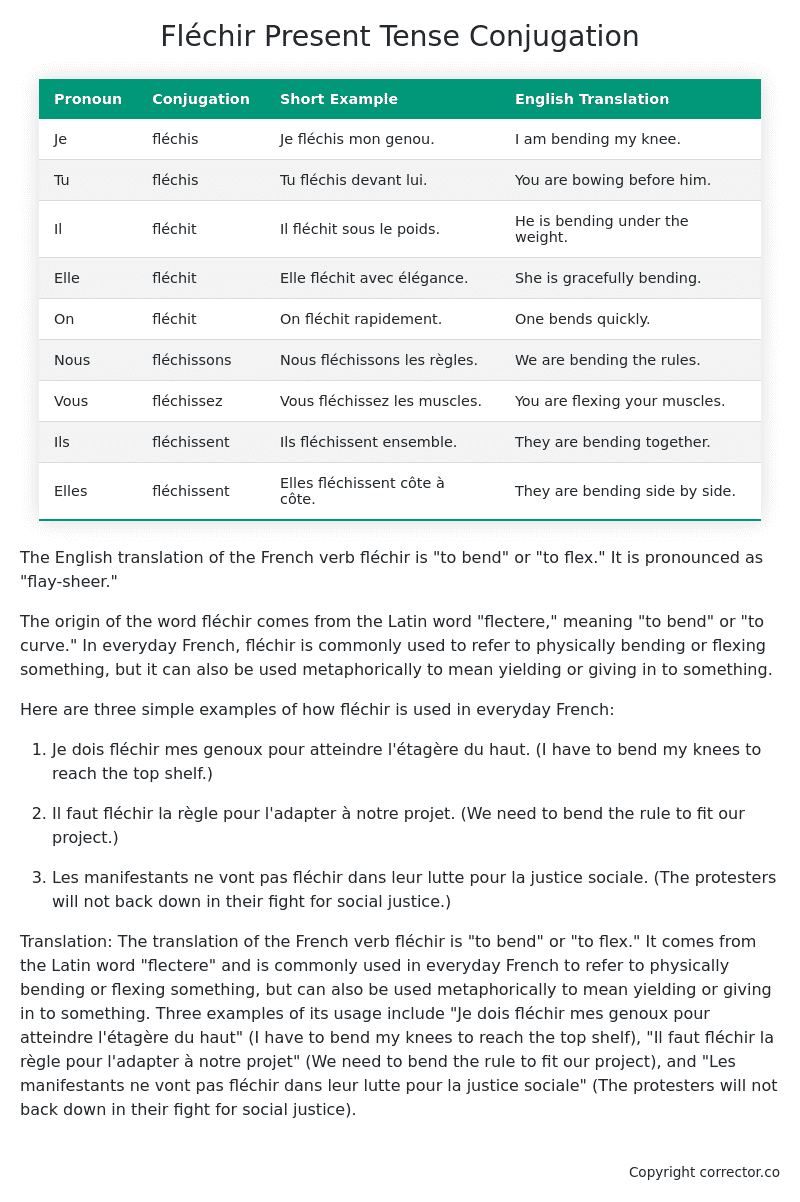Le Present (Present Tense) Conjugation of the French Verb fléchir
Introduction to the verb fléchir
The English translation of the French verb fléchir is “to bend” or “to flex.” It is pronounced as “flay-sheer.”
The origin of the word fléchir comes from the Latin word “flectere,” meaning “to bend” or “to curve.” In everyday French, fléchir is commonly used to refer to physically bending or flexing something, but it can also be used metaphorically to mean yielding or giving in to something.
Here are three simple examples of how fléchir is used in everyday French:
-
Je dois fléchir mes genoux pour atteindre l’étagère du haut. (I have to bend my knees to reach the top shelf.)
-
Il faut fléchir la règle pour l’adapter à notre projet. (We need to bend the rule to fit our project.)
-
Les manifestants ne vont pas fléchir dans leur lutte pour la justice sociale. (The protesters will not back down in their fight for social justice.)
Translation:
The translation of the French verb fléchir is “to bend” or “to flex.” It comes from the Latin word “flectere” and is commonly used in everyday French to refer to physically bending or flexing something, but can also be used metaphorically to mean yielding or giving in to something. Three examples of its usage include “Je dois fléchir mes genoux pour atteindre l’étagère du haut” (I have to bend my knees to reach the top shelf), “Il faut fléchir la règle pour l’adapter à notre projet” (We need to bend the rule to fit our project), and “Les manifestants ne vont pas fléchir dans leur lutte pour la justice sociale” (The protesters will not back down in their fight for social justice).
Fléchir – About the French Present Tense
To take a deep dive into all the French tenses then see our article on Mastering French Tense Conjugation.
Common Everyday Usage Patterns For Le Present
Interactions with Other Tenses
Table of the Present Tense Conjugation of fléchir
| Pronoun | Conjugation | Short Example | English Translation |
|---|---|---|---|
| Je | fléchis | Je fléchis mon genou. | I am bending my knee. |
| Tu | fléchis | Tu fléchis devant lui. | You are bowing before him. |
| Il | fléchit | Il fléchit sous le poids. | He is bending under the weight. |
| Elle | fléchit | Elle fléchit avec élégance. | She is gracefully bending. |
| On | fléchit | On fléchit rapidement. | One bends quickly. |
| Nous | fléchissons | Nous fléchissons les règles. | We are bending the rules. |
| Vous | fléchissez | Vous fléchissez les muscles. | You are flexing your muscles. |
| Ils | fléchissent | Ils fléchissent ensemble. | They are bending together. |
| Elles | fléchissent | Elles fléchissent côte à côte. | They are bending side by side. |
Other Conjugations for Fléchir.
Le Present (Present Tense) Conjugation of the French Verb fléchir (this article)
Imparfait (Imperfect) Tense Conjugation of the French Verb fléchir
Passé Simple (Simple Past) Tense Conjugation of the French Verb fléchir
Passé Composé (Present Perfect) Tense Conjugation of the French Verb fléchir
Futur Simple (Simple Future) Tense Conjugation of the French Verb fléchir
Futur Proche (Near Future) Tense Conjugation of the French Verb fléchir
Plus-que-parfait (Pluperfect) Tense Conjugation of the French Verb fléchir
Passé Antérieur (Past Anterior) Tense Conjugation of the French Verb fléchir
Futur Antérieur (Future Anterior) Tense Conjugation of the French Verb fléchir
Subjonctif Présent (Subjunctive Present) Tense Conjugation of the French Verb fléchir
Subjonctif Passé (Subjunctive Past) Tense Conjugation of the French Verb fléchir
Subjonctif Imparfait (Subjunctive Imperfect) Tense Conjugation of the French Verb fléchir
Subjonctif Plus-que-parfait (Subjunctive Pluperfect) Tense Conjugation of the French Verb fléchir
Conditionnel Présent (Conditional Present) Tense Conjugation of the French Verb fléchir
Conditionnel Passé (Conditional Past) Tense Conjugation of the French Verb fléchir
L’impératif Présent (Imperative Present) Tense Conjugation of the French Verb fléchir
L’infinitif Présent (Infinitive Present) Tense Conjugation of the French Verb fléchir
Struggling with French verbs or the language in general? Why not use our free French Grammar Checker – no registration required!
Get a FREE Download Study Sheet of this Conjugation 🔥
Simply right click the image below, click “save image” and get your free reference for the fléchir Present Tense tense conjugation!

I hope you enjoyed this article on the verb fléchir. Still in a learning mood? Check out another TOTALLY random French verb present conjugation!


